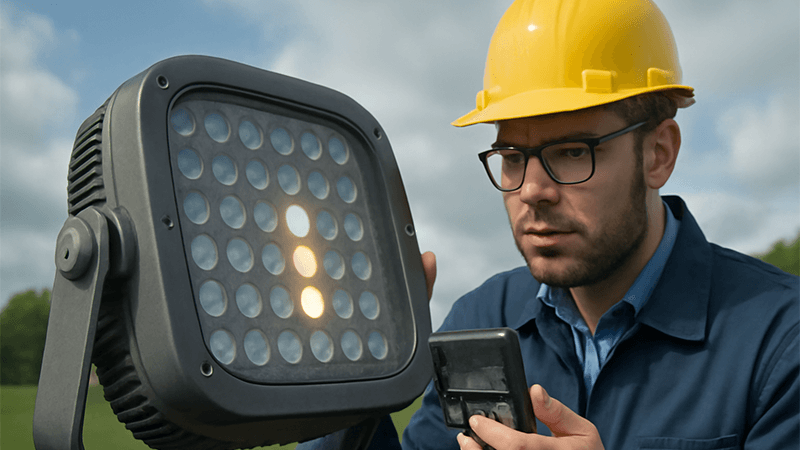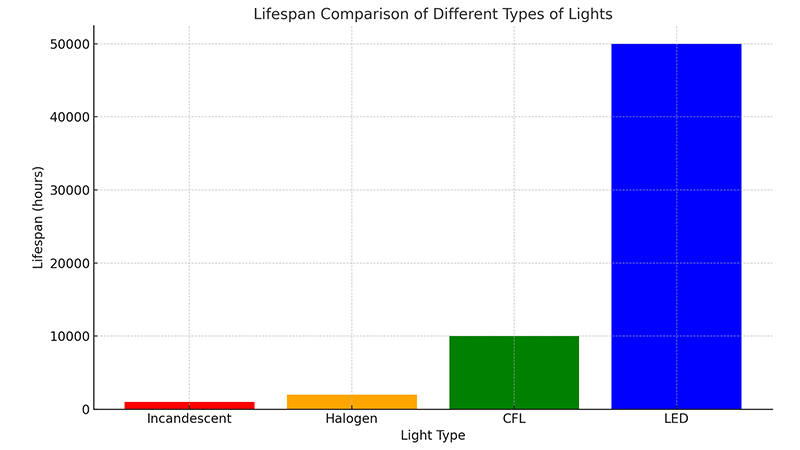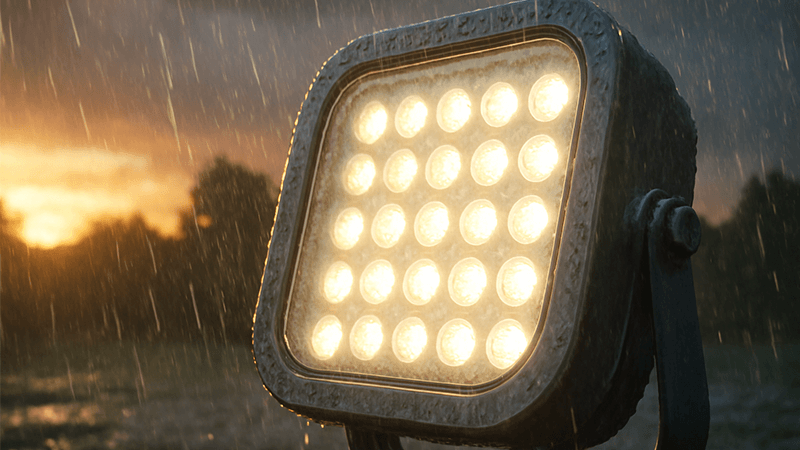Your LED flood lights keep failing, costing you time and money. This frustration makes you question their value. The key is understanding that the problem is rarely the LED itself.
The primary causes of early LED flood light failure are not the LED chips. Failures usually stem from the LED driver, poor heat management, water ingress due to faulty seals, or low-quality materials used in the housing and other components.

I’ve spent my entire career in the LED lighting industry, from working on the factory floor to building my own manufacturing business. I’ve seen firsthand why some lights last for a decade while others fail in a year. The "secret" isn’t a secret at all; it’s about quality control and understanding the entire system, not just the light source. It’s frustrating to see good technology get a bad name because of poor execution. Let’s dig into the real issues so you can make better purchasing decisions and ensure your projects succeed.
How long should LED flood lights last?
You invest in LEDs for their long life, but they fail early. This makes budgeting impossible and damages your reputation. Knowing the real lifespan helps you choose lights that deliver on their promise.
A good quality LED flood light should last from 30,000 to 50,000 hours. High-end models can exceed 100,000 hours. This translates to years of reliable operation, but the actual lifespan depends on component quality and the operating environment.

When we talk about lifespan in the LED industry, we often refer to the L70 rating. This isn’t the point of total failure. It’s the point at which the light’s output has degraded to 70% of its original brightness. For most professional applications, this is considered the end of its useful life. It’s crucial to understand this because a light can still be "on" but functionally useless long before it burns out completely. A cheap light might fail catastrophically in 10,000 hours, while a quality one will simply be less bright after 50,000 hours.
Factors That Determine Real-World Lifespan
The advertised hours are based on ideal lab conditions. In the real world, several factors can drastically shorten this lifespan. As a purchasing manager in the UAE like Shaz, you know that extreme heat is a major challenge. High ambient temperatures put immense stress on all electronic components, especially the driver. In addition, the number of hours the light is used per day plays a direct role. A light running 24/7 will reach its L70 limit much faster than one operating for only 8 hours a night.
| Factor |
Low-Quality Light Impact |
High-Quality Light Impact |
| Heat |
Rapid brightness loss, driver failure |
Stable performance due to better heat sinks |
| Usage Hours |
Fails much sooner than advertised |
Reaches L70 rating predictably |
| Sealing (IP Rating) |
Water/dust ingress causes short circuits |
Protected from elements, ensuring longevity |
| Power Surges |
Driver easily damaged |
Robust driver with surge protection |
Ultimately, a 50,000-hour rating is only meaningful if the entire fixture is built to last that long.
Why do LED lights go bad so fast?
You see the promise of 50,000 hours, but your lights die in months. This inconsistency is infuriating and costly. The truth is, the system fails, not just one part.
LED lights fail fast because of system-wide weaknesses. The LED driver is the most common point of failure, followed by inadequate heat sinks that cause overheating. Poor seals that allow moisture and dust inside also lead to rapid burnout.

In my experience, the LED driver is the number one culprit. It’s a complex piece of electronics responsible for converting AC power to the low-voltage DC power that LEDs need. A cheap driver uses low-grade components like capacitors that can’t handle heat or power fluctuations. When the driver dies, the light goes out, even if the LED chips themselves are perfectly fine. This is a classic case of a chain being only as strong as its weakest link. Manufacturers who cut corners on the driver are setting the product up for failure from the start.
The Critical Role of Heat Management
Heat is the silent killer of all electronics, and LEDs are no exception. While LEDs are much more efficient than old technologies, they still produce heat. This heat must be drawn away from the LED chip and dissipated into the air. If it isn’t, the chip’s temperature rises, which accelerates lumen depreciation and can lead to a color shift or complete failure.
Here’s where design and material choice become critical:
- Heat Sink Material: High-quality fixtures use pure aluminum (like ADC12) for their heat sinks because it has excellent thermal conductivity. Cheaper alternatives might use recycled aluminum with impurities or even plastic, which are terrible at dissipating heat.
- Heat Sink Design: A good heat sink has a large surface area with fins designed to maximize airflow. A poorly designed one, even if made from good material, won’t be effective. It’s a common cost-cutting measure to reduce the size and weight of the heat sink, but this directly compromises the light’s lifespan.
I’ve seen products where the heat sink is more for show than for function. When you’re sourcing products, pay close attention to the physical build of the fixture. A heavy, well-finned aluminum body is a good sign. A light that feels flimsy and has a smooth, small housing is a major red flag.
Why do LED lights fail so often?
Project after project, you face the same problem: recurring LED failures. You start to feel like the technology is unreliable. It’s not the tech; it’s the quality you’re buying.
LED lights seem to fail often because the market is flooded with low-quality products. Intense price competition forces manufacturers to cut corners on critical components like drivers, seals, and thermal management, leading to high failure rates across the board.

The problem is fundamentally an economic one. As a manufacturer, I face constant pressure to lower prices. But lowering prices without sacrificing quality is incredibly difficult. Something has to give. Many factories choose to use subpar components because the customer often can’t tell the difference just by looking at the product. A cheap driver looks similar to a good one, and a low-grade aluminum alloy can be painted to look premium. The difference only becomes apparent after a few months of operation in a demanding environment.
The Manufacturing and Assembly Problem
Even with good components, poor manufacturing processes can doom a product. Consistency is everything. If the thermal paste isn’t applied correctly between the LED board and the heat sink, it creates an air gap that traps heat. If the gaskets are not seated properly or are made of a material that degrades in sunlight, the IP rating becomes meaningless.
Here’s a breakdown of common manufacturing flaws I see:
- Poor Soldering: Weak or "cold" solder joints on the circuit board can fail due to vibration or thermal expansion, causing an open circuit.
- Inconsistent Sealing: Automated assembly is more consistent, but many low-cost factories rely on manual assembly. The quality of the seal can vary from one worker to another, leading to a high percentage of units that are not truly weatherproof.
- Lack of Testing: Reputable manufacturers perform multiple tests, including aging tests where lights are run for 48-72 hours straight to catch early failures. They also conduct IP testing on batches to verify weatherproofing. Low-cost producers often skip these critical quality control steps to save time and money.
When you see a high failure rate across a batch of lights, it often points directly back to these kinds of inconsistencies in the manufacturing line. This is why a long-term relationship with a trusted supplier who can prove their quality control processes is more valuable than saving a few dollars per unit.
Why are my LED lights not lasting long?
You followed the specs and installed the lights correctly, but they’re still dying early. You’re left wondering what you did wrong. It might not be you, but the environment.
Your LED lights may not be lasting long because of site-specific issues. These include unstable power supplies with frequent surges, extreme ambient temperatures, or installing a fixture with an inadequate IP rating for a very wet or dusty location.

When I consult with clients like Shaz who face premature failures, we often find the problem isn’t the light itself, but a mismatch between the product and its application. For example, a standard flood light might be rated for a maximum ambient temperature of 45°C. In the UAE, surfaces exposed to direct sunlight can get much hotter, causing the light’s internal temperature to exceed its design limits and triggering a rapid failure. The light wasn’t "bad," it was simply the wrong product for the job.
Matching the Product to the Environment
Choosing the right light is about more than just lumens and wattage. You must consider the specific environmental challenges of the installation site. Overlooking these details is a common and costly mistake.
Power Quality and Surge Protection
Power grids are not always stable. Voltage spikes and surges, caused by things like lightning strikes or heavy machinery turning on and off, can instantly destroy an LED driver.
- Solution: For areas with known power issues, you must specify lights with enhanced surge protection (e.g., 6KV or 10KV). A standard driver might only have 2KV protection, which is not enough. You can also install external surge protection devices for added security on a critical project.
Water and Dust Ingress Protection (IP Rating)
The IP rating is one of the most important specifications for outdoor lighting. An IP65 rating is generally considered the minimum for outdoor use, protecting against jets of water. However, for a location with heavy rainfall, frequent high-pressure washing, or potential for temporary submersion, you need IP66 or even IP67.
- Solution: Don’t just accept the advertised IP rating. Ask the supplier for third-party test reports. A reliable manufacturer will have this documentation ready. I always advise clients to select a rating one level higher than the minimum required if the budget allows, especially for hard-to-reach installations where maintenance is expensive.
By carefully analyzing the installation environment and specifying a product with the right protective features, you can ensure your LED lights achieve their full potential lifespan.
Conclusion
LED flood light failure is rarely about the LED chip. It’s about weak drivers, poor heat management, and low-quality manufacturing. Choose suppliers who prioritize quality over cost to ensure longevity.